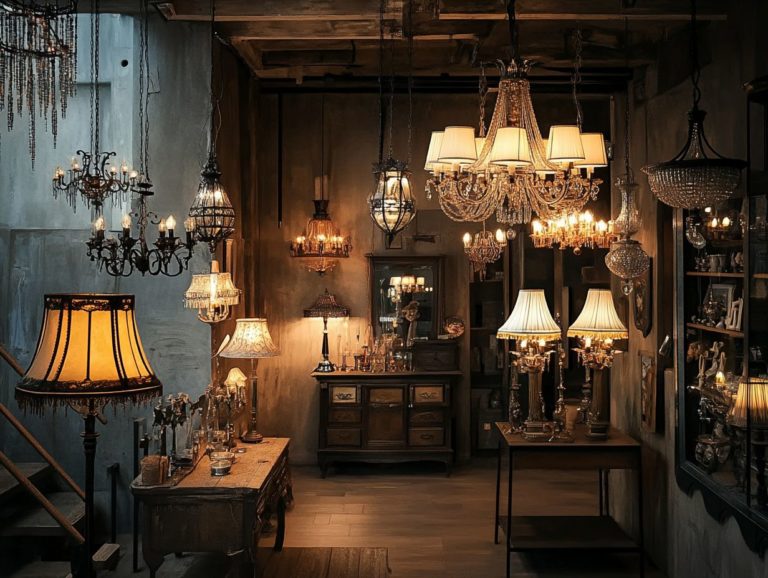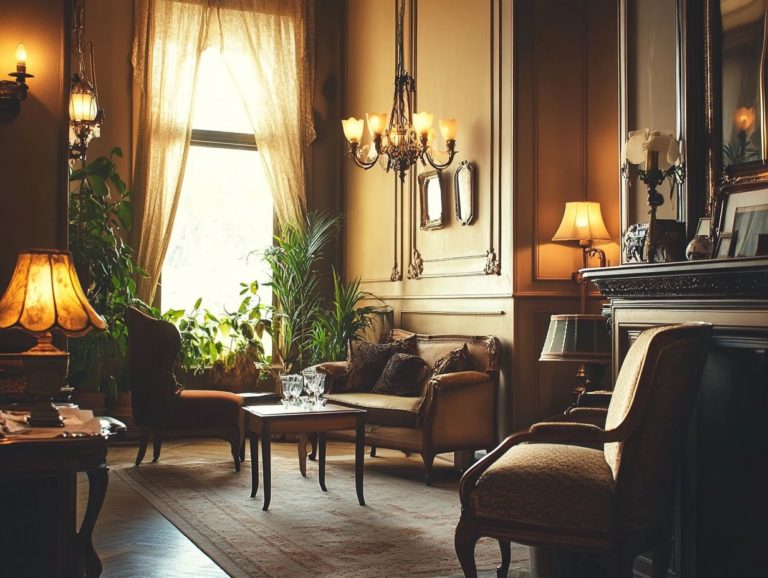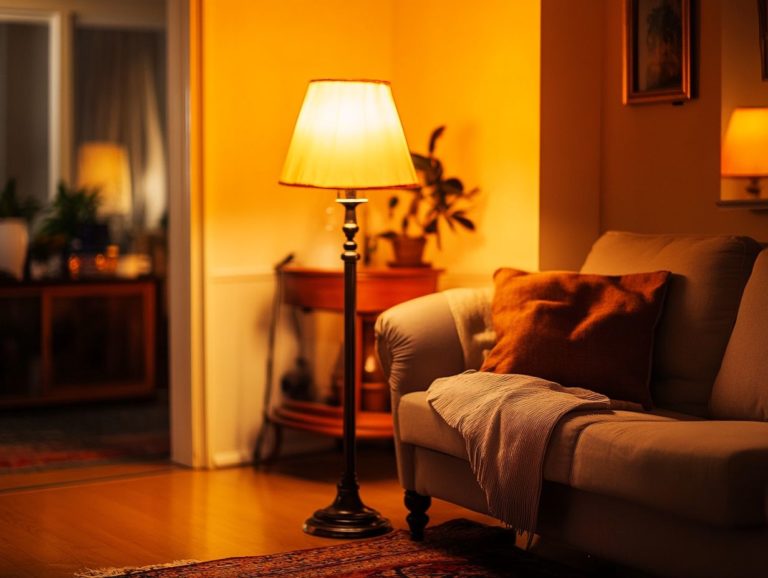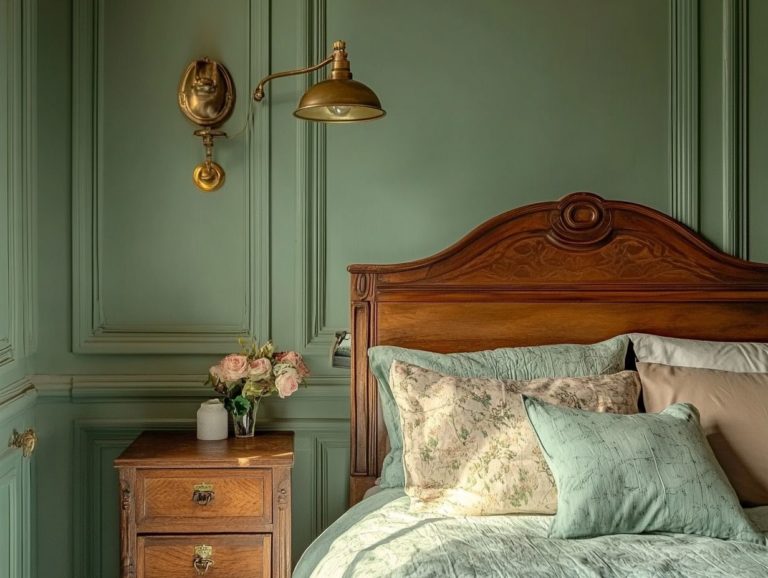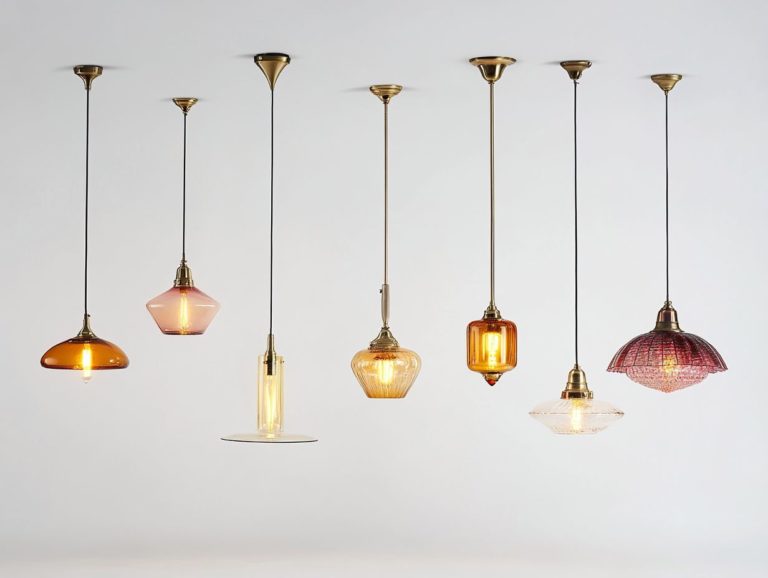How to Assess the Quality of Vintage Lighting
Vintage lighting brings an undeniable charm and a sense of history to any space. However, discerning what qualifies as truly vintage can be quite the challenge.
This guide walks you through essential factors to consider when assessing quality, including materials, craftsmanship, functionality, and safety. Learn to spot authentic vintage pieces easily, recognize reproductions, and evaluate their condition.
You will also find valuable tips for determining their worth in a constantly shifting market.
Whether you re an avid collector or simply aiming to elevate your home decor, this guide will empower you with exciting insights!
Contents
- Key Takeaways:
- Understanding Vintage Lighting
- Factors to Consider When Assessing Quality
- Identifying Authentic Vintage Lighting
- Assessing the Condition of Vintage Lighting
- Tips for Evaluating the Value of Vintage Lighting
- Frequently Asked Questions
- What is considered vintage lighting?
- How can I assess the quality of vintage lighting?
- What are some common materials used in vintage lighting?
- Are there specific brands known for high-quality vintage lighting?
- What should I look for when purchasing vintage lighting?
- Can I use vintage lighting in my home?
Key Takeaways:
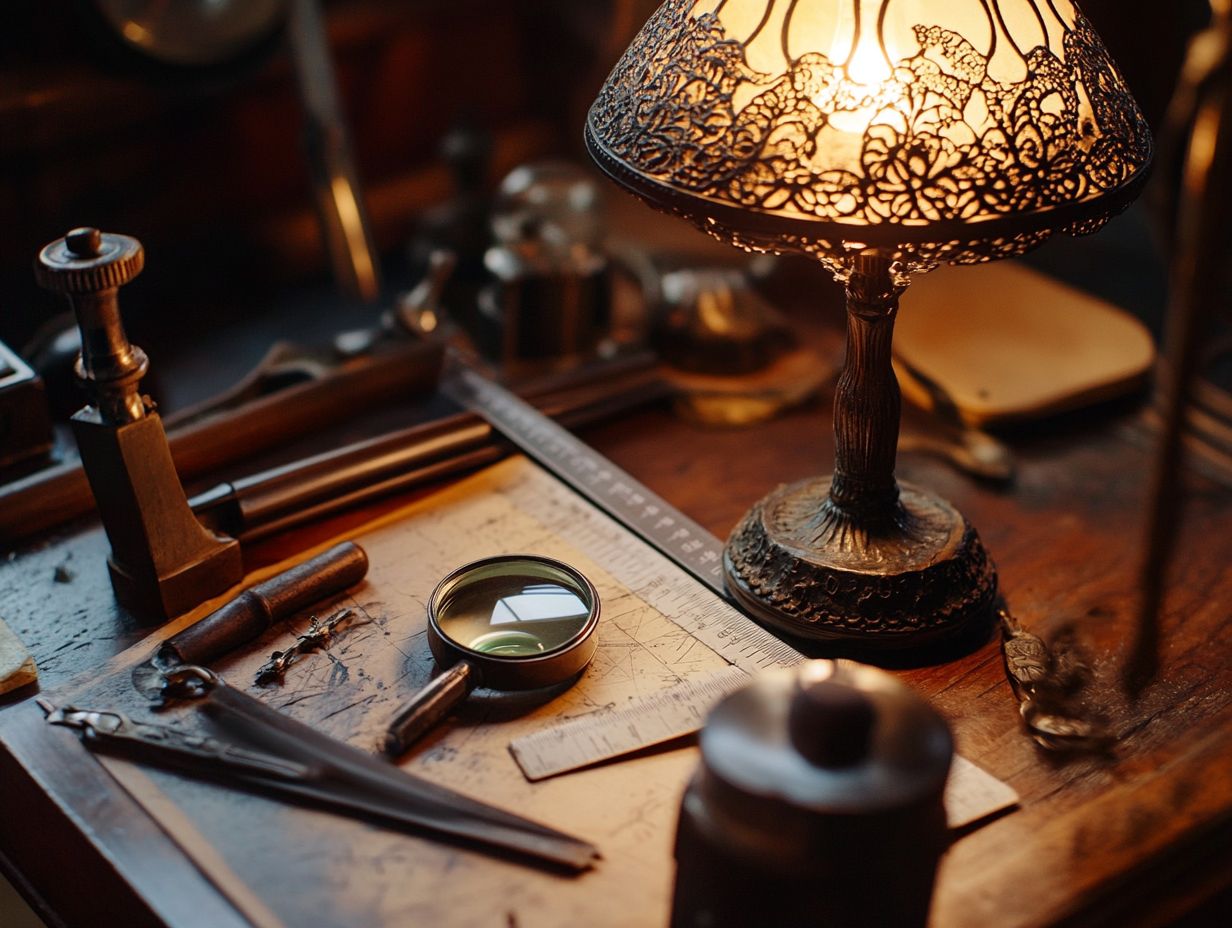
- Look for high-quality materials and expert craftsmanship when assessing vintage lighting.
- Consider functionality and safety, as outdated wiring and construction can pose hazards.
- Learn how to identify signs of authenticity and spot reproductions to ensure the value of your vintage lighting pieces.
Understanding Vintage Lighting
Understanding vintage lighting is essential for enthusiasts and collectors alike. It offers a captivating array of design styles, craftsmanship, and historical significance that can elevate your home d cor.
From the intricate details of mid-century modern to the lavish glamour of Art Deco, vintage lighting embodies a unique aesthetic. It serves as a testament to the artistry of bygone eras.
Restoration specialists, like Loomlight, are dedicated to preserving these exquisite fixtures. They ensure each piece retains its charm while adhering to modern electrical safety standards.
Dive into the world of vintage lighting and uncover how it can illuminate your living spaces with character and elegance.
What Makes Lighting ‘Vintage’?
Lighting takes on a vintage quality when it embodies the styles and craftsmanship of specific historical periods. It evokes a sense of nostalgia and offers decorative appeal that resonates with both collectors and interior designers.
You’ll find that vintage lighting showcases a variety of materials, including brass, glass, and ceramic. Each reflects the technological advancements and artistic movements of its time. Vintage lamps, often hailing from iconic design eras like Art Deco or mid-century modern, possess an allure that transcends mere functionality. To enhance their beauty, consider learning how to frame your vintage lighting, making them conversation starters and focal points within your living space.
Each unique antique piece carries its own story, enriching the vintage aesthetic and infusing charm and character into homes that value history. This harmonious blend of materials and design sensibility elevates vintage lighting from a simple choice to an experience that resonates profoundly with enthusiasts.
Factors to Consider When Assessing Quality
When evaluating the quality of vintage lighting, several critical factors demand your attention. Consider the craftsmanship, the materials used, and adherence to electrical safety standards.
Each of these elements is essential for ensuring both aesthetic appeal and functional integrity.
Materials and Craftsmanship
The materials and craftsmanship in vintage lighting are crucial in determining its authenticity and aesthetic appeal. When you come across quality materials like Murano glass and brass chandeliers, you re witnessing superior design and artistry at their finest.
These components enhance the visual richness of each piece and reflect the careful methods employed by skilled artisans. Take Tiffany lamps, for example they’re famous for their intricate stained glass designs, where artisans painstakingly hand-cut and soldered pieces to create complex patterns that cast breathtaking colors when illuminated.
Similarly, the use of wrought iron in antique sconces adds a rustic charm while offering durability that stands the test of time. The blend of materials like crystal and wood not only adds character but also elevates the fixture’s historical significance, ensuring it remains a timeless treasure in any setting you choose.
Don’t miss out on the chance to discover vintage pieces that could transform your space! Dive into the world of authentic vintage lighting today and find the perfect piece for your home!
Functionality and Safety
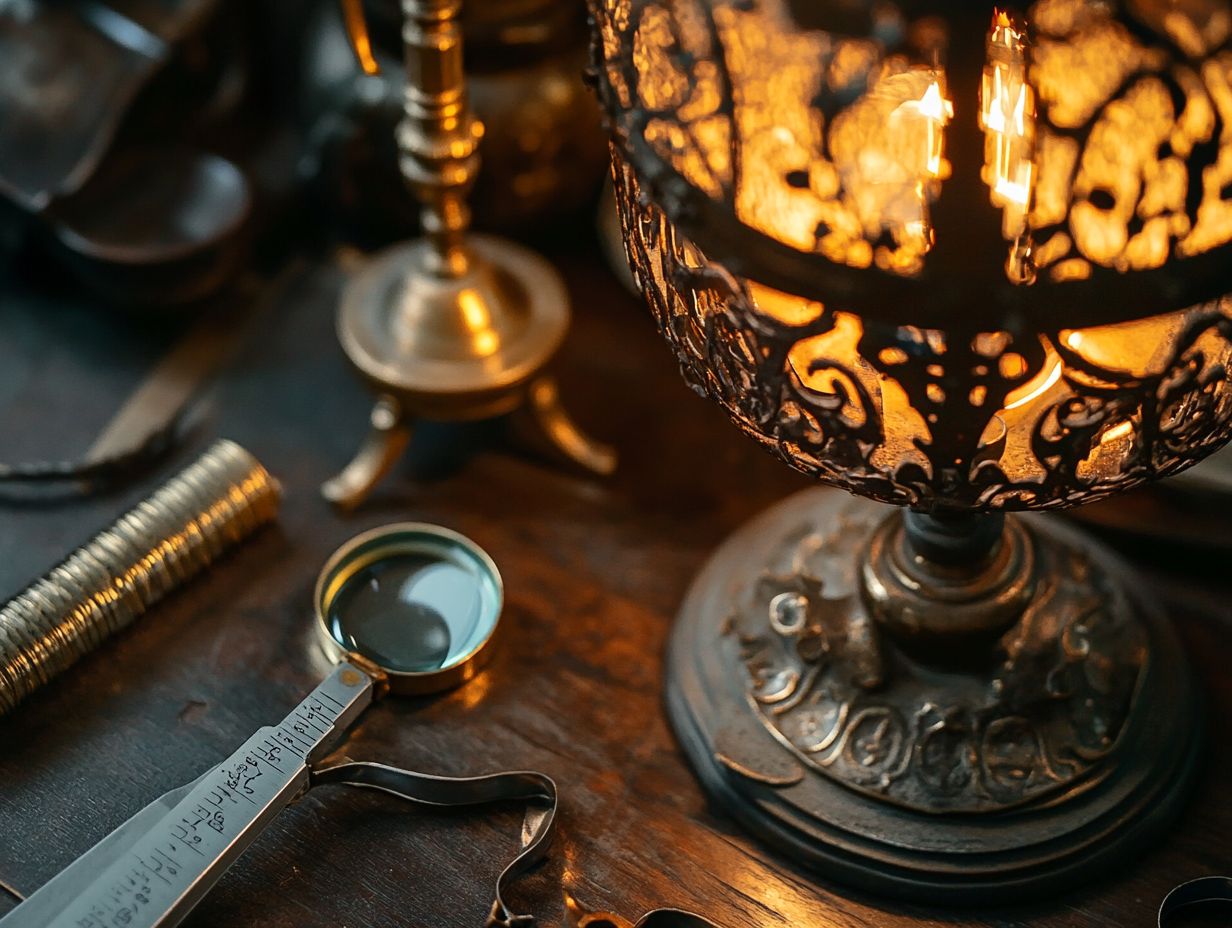
The functionality and safety of vintage lighting are paramount. Many older fixtures might not meet today s modern electrical safety guidelines. This calls for thorough assessments by restoration specialists.
These specialists evaluate the structural integrity of your lighting. They also replace outdated electrical components that could pose potential hazards, such as overheating and short-circuiting.
By updating the wiring and other essential parts, they seamlessly bridge the gap between the charming aesthetics of yesteryear and the contemporary safety requirements you need.
Their expertise is crucial in preserving historical value. This ensures these beautiful pieces can continue to enhance your living spaces without compromising safety. Ultimately, this collaboration between vintage charm and modern functionality creates an inviting atmosphere that honors the past while addressing your present needs.
Identifying Authentic Vintage Lighting
Identifying authentic vintage lighting demands your keen eye for details. Genuine pieces often showcase specific characteristics that set them apart from reproductions.
It s essential for collectors like you to recognize these signs of authenticity to truly appreciate the value and history behind each piece.
Signs of Authenticity
When evaluating vintage lighting, look for signs of authenticity that help you distinguish genuine pieces from modern reproductions. Pay close attention to craftsmanship, materials, and the historical context tied to different vintage design eras.
For example, the quality of craftsmanship reveals the methods and tools used in a specific period. Handmade features, like intricate engravings or distinctive glasswork, are strong indicators of authenticity.
The materials whether brass fittings or hand-blown glass can hint at the era in which the piece was made. Look for unusual details, such as specific patterns or design motifs, as these can serve as valuable clues.
By familiarizing yourself with these characteristics, you’ll develop a discerning eye. This will make it much easier to spot true vintage lighting that stands apart from less scrupulous reproductions. Additionally, knowing how to care for your vintage lighting will ensure it remains in excellent condition for years to come.
How to Spot Reproductions
Spotting reproductions in the vintage lighting market can be quite the challenge. If you understand key indicators like inferior craftsmanship, subpar materials, and a lack of historical features you can deftly sidestep potential pitfalls.
It’s crucial to focus on the details that distinguish authentic pieces. Reproductions often cut corners on high-quality finishes, opting for cheaper alternatives that compromise both appearance and durability.
When appraising a lamp, closely inspect the wiring, light sockets, and overall construction. These components often reveal the true age and design intent of the fixture.
Familiarizing yourself with the authentic historical context can offer invaluable insights. This enables you to discern between genuine vintage lighting and modern imitations, ensuring your investments are not only authentic but also valuable. For those looking to enhance their collection, exploring the best places to find vintage lighting can be incredibly rewarding.
Assessing the Condition of Vintage Lighting
Evaluating the condition of vintage lighting is crucial, whether you re a collector or a restorer. This assessment impacts not just the visual appeal but also its functionality and safety.
It necessitates a meticulous inspection to identify common wear and tear. This ensures that your prized piece remains both beautiful and reliable.
Common Wear and Tear

Common wear and tear on vintage lighting reveals itself in various forms, from tarnished finishes on your cherished antique lamps to frayed electrical cords. Thus, thorough evaluations by specialists are vital for preservation.
These imperfections not only diminish the aesthetic allure of your pieces but can also pose significant safety risks. For instance, broken glass shades or loose wiring can lead to hazardous situations if not addressed promptly. Restoring vintage outdoor lighting can help mitigate these issues and enhance your space.
Restoration specialists possess the expertise to identify these concerns. They meticulously evaluate the structural integrity of each piece and assess the functionality of its components. With their skilled hands, they maintain the delicate balance between heritage and safety, revitalizing your treasured items while retaining their historical charm.
Adopting this proactive approach is essential in preserving the beauty and functionality of vintage lighting for future generations to enjoy.
Signs of Damage or Restoration
Recognizing signs of damage or previous restoration is essential when you evaluate vintage lighting, as improper repairs can diminish both the aesthetic appeal and safety of the fixture.
A discerning eye allows you to identify the craftsmanship and quality of the electrical components, ensuring that the piece not only captivates but also functions reliably. Look for uneven patinas, mismatched screws (screws that do not match in size, shape, or color), or signs of overpaint, as these may indicate rushed repairs. For more tips on identifying fine pieces, explore how to spot quality vintage furniture. High-quality restorations typically focus on original details, employing authentic materials and period-appropriate techniques.
Examining the wiring can also shed light on the integrity of a restoration. While modernized electrical components are vital, they should harmonize with the vintage style rather than disrupt it. For those looking to enhance their vintage lighting, understanding how to choose vintage light bulbs is essential. Ensuring that these elements align can significantly enhance the overall charm and reliability of your vintage lighting piece.
Tips for Evaluating the Value of Vintage Lighting
Evaluating the value of vintage lighting requires a discerning eye for key factors that contribute to its worth. Be sure to consider elements like age, condition, and rarity, along with current market trends that can significantly impact both demand and pricing.
Factors that Affect Value
The value of vintage lighting is shaped by a variety of factors that you should consider, from the quality of the fixtures and their unique designs to market trends and the specific vintage eras they embody.
As a collector, you ll find that rarity plays a significant role. Limited production pieces or those linked to renowned designers often command higher prices. The brand’s reputation is another key element; certain manufacturers are highly sought after because of their craftsmanship or historical significance.
Condition matters immensely, too. Well-preserved items usually fetch greater value than those that show signs of wear. Provenance can add an intriguing layer to a piece’s story, making it even more desirable.
Keep an eye on current market trends as they can influence your purchasing decisions. Trends like the resurgence in mid-century modern styles can lead you toward specific types of lighting that resonate with contemporary tastes.
Pricing and Market Trends
Understanding pricing and market trends is crucial for collectors like you looking to make smart purchases, given that values can shift dramatically based on factors like popularity, rarity, and demand.
External influences, including economic conditions, emerging design trends, and even the impact of social media, significantly shape market dynamics. For example, particular styles may see a resurgence in popularity due to trends in home d cor, which can drive prices up sharply.
You should remain vigilant about these shifts, perhaps by keeping an eye on industry publications and attending trade shows. In terms of appraisals, seeking multiple perspectives from seasoned appraisers can provide a more accurate understanding of an item’s worth in today s financial landscape. This knowledge gives you the power to make more strategic buying and selling decisions.
Frequently Asked Questions
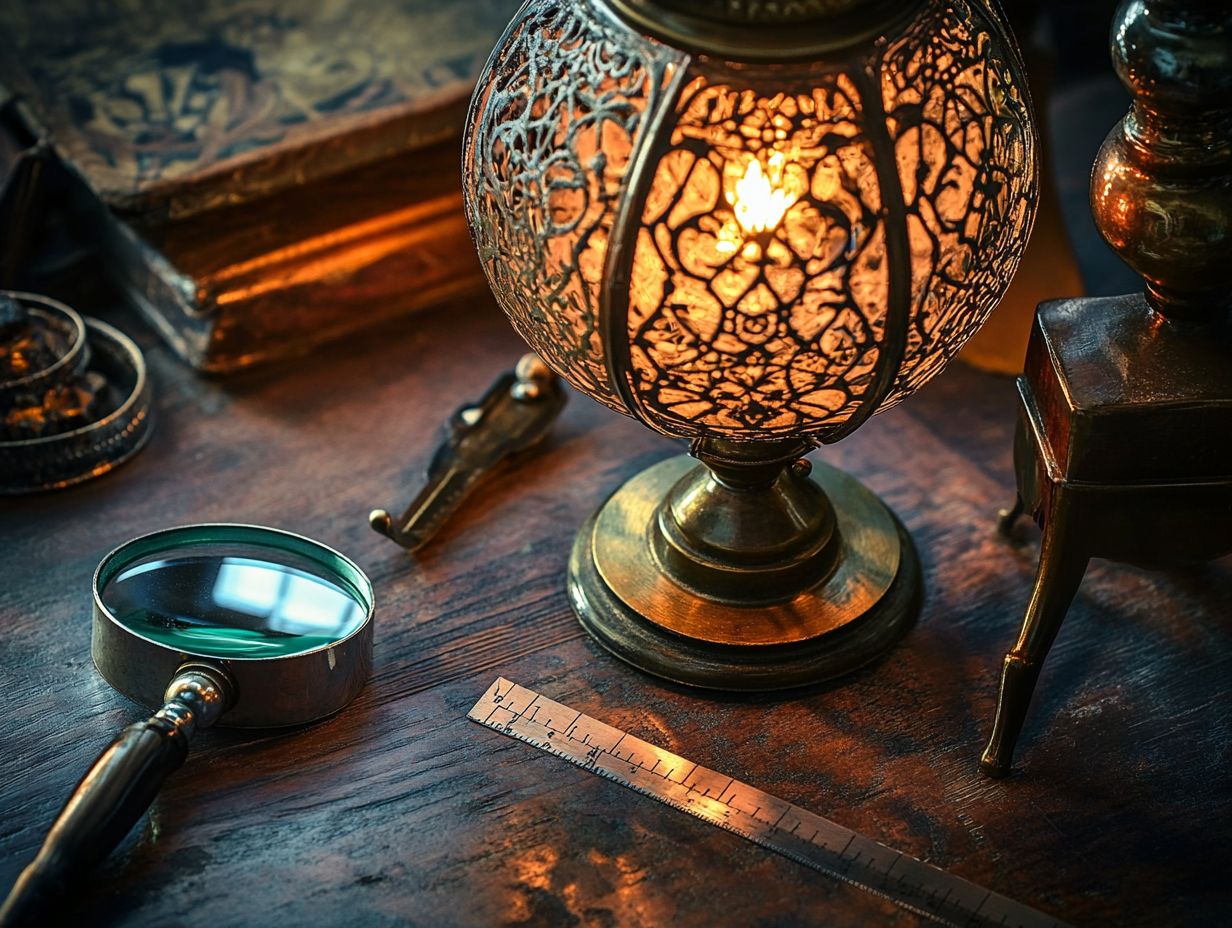
What is considered vintage lighting?
Vintage lighting refers to fixtures made at least 20 years ago that are no longer produced. These pieces are popular among collectors and home decorators.
How can I assess the quality of vintage lighting?
Check the materials, construction, and overall condition of the fixture. Look for any wear, rust, or damage, and test any electrical components.
What are some common materials used in vintage lighting?
Brass, copper, glass, and various types of wood are common in vintage lighting. These materials were often handcrafted and are of high quality, enhancing the fixture’s value.
Are there specific brands known for high-quality vintage lighting?
Yes! Brands like Tiffany & Co., Art Deco, and Murano are renowned for their quality. Familiarize yourself with these names to spot genuine vintage pieces.
What should I look for when purchasing vintage lighting?
Examine the condition, authenticity, and rarity of the fixture. Pay attention to the materials and any past repairs, and consider consulting a professional collector.
Can I use vintage lighting in my home?
Absolutely! Vintage lighting adds a unique touch to any space. Just make sure it’s safe and functioning before installation, and consult a licensed electrician for help.

